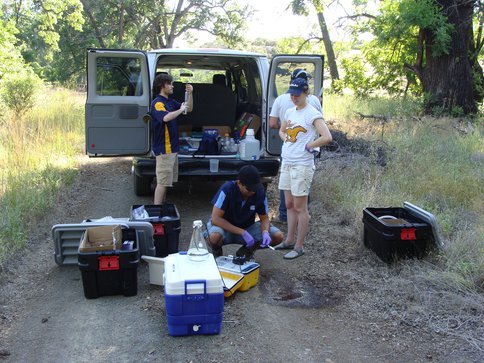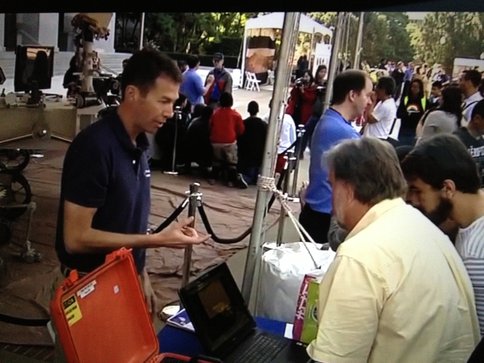2013 Annual Science Report
 NASA Ames Research Center
Reporting | SEP 2012 – AUG 2013
NASA Ames Research Center
Reporting | SEP 2012 – AUG 2013
Mineralogical Traces of Early Habitable Environments
Project Summary
The goal of our work is to understand how habitability (potential to support life) varies across a range of physical and chemical parameters, in order to support a long term goal of characterizing habitability of environments on Mars.
The project consists of two main components:
1. We are examining the interplay between physicochemical environment and associated microbial communities in a subsurface environment dominated by serpentinization (a reaction involving water and crustal rocks, which indicated by surface mineralogy to have occurred on ancient Mars).
2. We are working to understand how mineral assemblages can serve as a lasting record of prior environmental conditions, and therefore as indicators of prior habitability. This component directly supports the interpretation of mineralogy data obtained by the CheMin instrument on the Mars Science Laboratory.
Project Progress
Efforts during the performance period were focused in two main areas:
Coast Range Ophiolite Microbial Observatory (CROMO):
Samples for aqueous geochemistry and molecular biology were collected and analyzed quarterly from the borehole observatories established in 2011, as part of a well recovery and seasonal monitoring campaign. We also established an initial suite of microbial colonization experiments within the boreholes. To our knowledge, this is the first suite of time-resolved down-hole colonization experiments to have been deployed in actively serpentinizing subsurface. A first round of post-deployment monitoring has been conducted, with results presented in several 2013 AGU abstracts and in prep for submission. An extensive metagenomic and pyrotag sequencing analysis of fluids and solid material from the new wells was conducted and compared against in situ metabolic activity assays. Initial results demonstrate that, when arrayed against a series of other serpentinizing systems, the highest-pH CROMO wells have the lowest genetic diversity yet observed. The high pH samples also demonstrate very low to unmeasurable metabolic consumption of hydrogen and CO, suggesting that our sites span a gradient that may encompass marginally or uninhabitable conditions. Finally, our method for clean drilling (which utilized steam-sterilized drill bits and purified drinking water as drill fluid) and contamination monitoring (introduction of microbe-sized fluorescent spheres into the drill fluid) was published in Scientific Drilling.
In parallel, we worked to develop a numerical model that determines the supply and demand of metabolic energy as a function of fluid composition, and ultimately as a function of host rock composition. The model is applied to demonstrate the range in habitability across a range of serpentinizing fluid chemistries, including those at CROMO, and across the hypothetical chemical space represented by the range of naturally-occurring ultramafic rock compositions. Two manuscripts are currently in preparation based on these efforts. We also published a paper in Nature Reviews Microbiology that surveys the current understanding of microbial life in very low energy surroundings – a conceptual link between the CROMO field work, the modeling effort, and attempts to understand the biological potential of the subsurface on Mars, Europa, and other bodies that might offer habitable subsurface niches.
Mars Science Laboratory surface operations:
Team members Blake, Des Marais, Morris, and Treiman were heavily engaged in surface operations of the Mars Science Laboratory, as part of the CheMin (X-ray diffraction) instrument team. The team performed the first ever X-ray diffraction analysis on the surface of another world. Comparative mineralogical analysis, as partially informed by analysis of mineral alteration samples collected during the early phase of our project, was a critical component of the assessment of prior habitable conditions at the “Yellowknife Bay” site. Results of these efforts were published in Science, as part of the first round of MSL science papers.
Publications
-
(no authors found) (2013). Comparative Climatology of Terrestrial Planets. []. doi:10.2458/azu_uapress_9780816530595
-
Bishop, J. L., Loizeau, D., McKeown, N. K., Saper, L., Dyar, M. D., Des Marais, D. J., … Murchie, S. L. (2013). What the ancient phyllosilicates at Mawrth Vallis can tell us about possible habitability on early Mars. Planetary and Space Science, 86, 130–149. doi:10.1016/j.pss.2013.05.006
-
Blake, D. F., Morris, R. V., Kocurek, G., Morrison, S. M., Downs, R. T., Bish, D., … Zorzano Mier, M-P. (2013). Curiosity at Gale Crater, Mars: Characterization and Analysis of the Rocknest Sand Shadow. Science, 341(6153), 1239505–1239505. doi:10.1126/science.1239505
-
Burow, L. C., Woebken, D., Marshall, I. P., Lindquist, E. A., Bebout, B. M., Prufert-Bebout, L., … Singer, S. W. (2012). Anoxic carbon flux in photosynthetic microbial mats as revealed by metatranscriptomics. ISME J, 7(4), 817–829. doi:10.1038/ismej.2012.150
-
Cardace, D., Hoehler, T., McCollom, T., Schrenk, M., Carnevale, D., Kubo, M., & Twing, K. (2013). Establishment of the Coast Range ophiolite microbial observatory (CROMO): drilling objectives and preliminary outcomes. Sci. Dril., 16, 45–55. doi:10.5194/sd-16-45-2013
-
Finke, N., Hoehler, T. M., Polerecky, L., Buehring, B., & Thamdrup, B. (2013). Competition for inorganic carbon between oxygenic and anoxygenic phototrophs in a hypersaline microbial mat, Guerrero Negro, Mexico. Environmental Microbiology, 15(5), 1532–1550. doi:10.1111/1462-2920.12032
-
Hoehler, T. M., & Jørgensen, B. B. (2013). Microbial life under extreme energy limitation. Nat Rev Micro, 11(2), 83–94. doi:10.1038/nrmicro2939
-
Jahnke, L. L., Turk-Kubo, K. A., N. Parenteau, M., Green, S. J., Kubo, M. D. Y., Vogel, M., … Des Marais, D. J. (2013). Molecular and lipid biomarker analysis of a gypsum-hosted endoevaporitic microbial community. Geobiology, 12(1), 62–82. doi:10.1111/gbi.12068
-
Klatt, C. G., Inskeep, W. P., Herrgard, M. J., Jay, Z. J., Rusch, D. B., Tringe, S. G., … Miller, S. R. (2013). Community Structure and Function of High-Temperature Chlorophototrophic Microbial Mats Inhabiting Diverse Geothermal Environments. Frontiers in Microbiology, 4. doi:10.3389/fmicb.2013.00106
-
Pappalardo, R. T., Vance, S., Bagenal, F., Bills, B. G., Blaney, D. L., Blankenship, D. D., … Soderlund, K. M. (2013). Science Potential from a Europa Lander. Astrobiology, 13(8), 740–773. doi:10.1089/ast.2013.1003
-
Stüeken, E. E., Anderson, R. E., Bowman, J. S., Brazelton, W. J., Colangelo-Lillis, J., Goldman, A. D., … Baross, J. A. (2013). Did life originate from a global chemical reactor?. Geobiology, 11(2), 101–126. doi:10.1111/gbi.12025
- Cardace, D., O’Donnell, A., Murray, D.P. & Veeger, A.I. (2013). Connecting in-service teachers to Google Earth and Google Mars through the NSF-MSP-RITES Project (Oral Talk). Paper 52-4. 48th Annual Regional Meeting of the Geological Society of America Northeastern Section Northeastern Section (18–20 March 2013).
-
PROJECT INVESTIGATORS:
-
PROJECT MEMBERS:
David Blake
Co-Investigator
Linda Jahnke
Co-Investigator
Mike Kubo
Co-Investigator
Richard Morris
Co-Investigator
Niki Parenteau
Co-Investigator
Matthew Schrenk
Co-Investigator
Allan Treiman
Co-Investigator
Sherry Cady
Collaborator
Dawn Cardace
Collaborator
Thomas McCollom
Collaborator
Kenneth Stedman
Collaborator
Roger Summons
Collaborator
-
RELATED OBJECTIVES:
Objective 2.1
Mars exploration.
Objective 5.3
Biochemical adaptation to extreme environments


